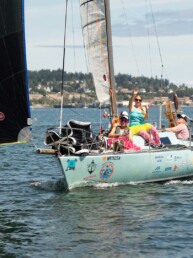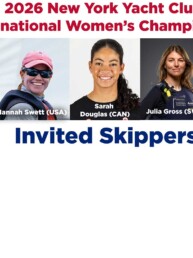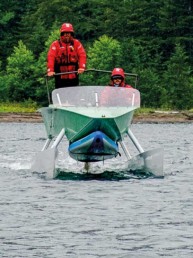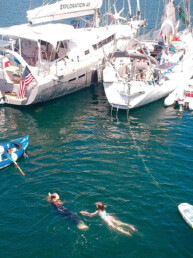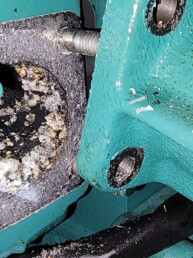Team Gratitude was one of 56 teams who challenged themselves in the inaugural WA360 Race from Port Townsend to Olympia to Point Roberts and back to Port Townsend.
After much deliberation and possibly a dark-and-stormy or two, I decided to join a new sailing team that was registered for the inaugural Washington 360 Race (WA360). I’ve been buoy racing since I was 12 years old but, until now, I had never raced more than 100 miles or 24 hours, whichever came first. Lucky for me, a group of cruising friends were putting together a fun program on Ben Kershner’s Melges 24, Team Gratitude. The crew of well-seasoned adventurers had plenty of experience to lend, from offshore Hobie sailing (Judah) to crossing the straits in gale force winds (Ben, Sarah).
Our goal was to turn a wet-sailed 100 series (read: older and without the fastest bottom) 24-foot sport boat into a liveable racing vessel. Twenty-four feet may sound small, but after building out two awesome bunk extensions made of plywood and paracord, we renamed the boat our two-bedroom four-bath — it would probably rent for around $1,800 a month in Seattle. Add in a few creative storage solutions for food and dry bags, and we had ourselves a pretty good setup.
The WA360 has very few rules; human power is allowed, but engines are not. Our biggest modifications were adding two trapeze wires on each side (in case of big breeze) and a pedal drive (in case of no breeze). Fast forward a few months of practice sails, unending boat work days and late night planning sessions, and we found ourselves in Port Townsend putting on the finishing touches. The wind forecasts didn’t look too promising but the pedal drive would give us an extra 2 knots speed when we needed it. Still, with a course that brings racers from Port Townsend to Olympia, then inside Whidbey Island, through either the Swinomish Channel or Deception Pass, into Bellingham Bay, and on to Point Roberts before returning to Port Townsend… That would be an awfully long way to pedal.
When race day finally came, we were presented with two questions — why do they start a 360 mile race at 6 in the morning, and should we take the Port Townsend Canal? The Canal is easy to write off, but it looked like a strong option, both for potential current relief and to shave off some distance. We were relieved to see some other teams head in that direction, and we followed their lead.
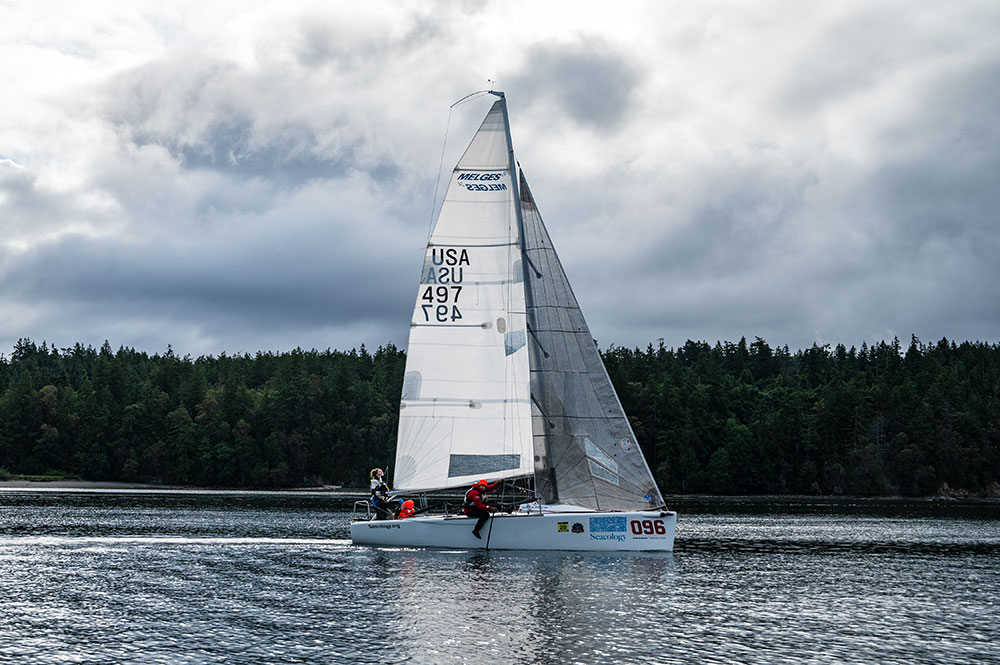
Our first tactical decision in the books and it paid off. There was just one hitch: the current absolutely rips north under that bridge, and it turns out you can’t go between the pilings and the shore on the far right side. Trust us on that one. Another hot tip: don’t put the person who’s looking at the chart on the pedal drive, facing backwards… It was a soft grounding, and we continued on fairly unscathed, if a little embarrassed.
We emerged from the canal having picked off a couple boats and were excited to work the next stretch of the course. We dug our way into a building southerly breeze and had a blast match racing the other Melges for a while. This was probably our first inkling that our boat might be able to hold its own. There were some fun stories flying around already, and we heard about one woman, Team Interstice, who was rowing straight down Hood Canal and planned to portage her boat the 2 miles over land to Case Inlet in south Puget Sound. Major points for creativity!
We cruised along at 6 or 7 knots down to Foulweather Bluff until about 1 p.m when the wind shut off and wouldn’t reappear until well into the next day. At this point, we were wondering if we’d signed up for a bike race. We took 30 minute shifts on the pedal drive, rotating to conserve energy. As we approached Vashon Island, there was much debate about whether or not to actually take Colvos Passage. The age old adage is that Colvos always flows north, but that’s not necessarily true. You don’t usually find breeze on the west side of Vashon, but Colvos does cut about five miles off the course. We tried hoisting a spinnaker but it was short lived, and we continued to pedal. I was scheduled for the first shift off watch from 6 p.m. to midnight.
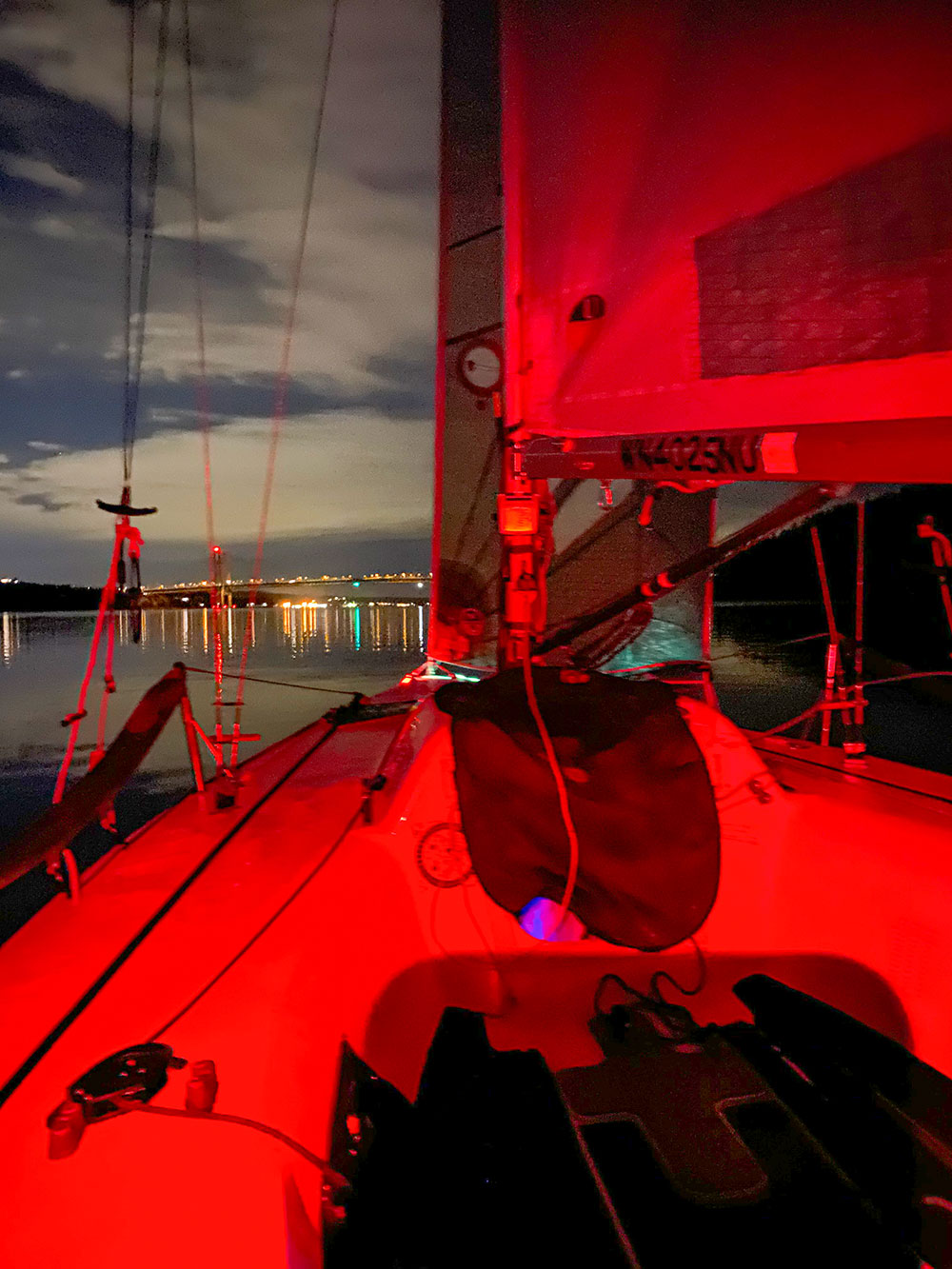
Colvos was definitely a winning move. It was a long night of working the various eddies, but we finally made it to Tacoma Narrows around 2:30 a.m. during a big flood. Perfect! Sarah and I drove under the bridge while the guys slept, coasting quietly beneath a moonless night brimming with stars. We caught up with Team Sail Like a Girl’s Melges 32 more than once, but they always managed to get away. Slowly, the world started to wake up around us with an orange sky and very little wind. We made the decision to go north of Anderson Island trying to save even more distance, but got caught in some big adverse current that we weren’t expecting.
Day 2 was a wild one! We turned the corner for Olympia around noon and we hadn’t seen wind in ages. The four of us took turns on the pedals on what felt like an 80 degree day. By 2 p.m. we were soaking our hats and t-shirts in the ice cold saltwater and putting them back on just to cool down. So. Much. Pedaling! Exiting Olympia Shoal, we were trying to get a little creative by taking a shortcut along a shallow area when we noticed a huge, dark shelf cloud looming on the eastern horizon. A front was filling in, and fast. Judah identified the cloud as matching one he saw in the Gulf of Mexico before a 45 knot squall, and we got busy preparing the boat for a big blow. We went from barefoot and shorts to full foul weather gear, life jackets, tethers, trapeze harnesses, boots, and even managed to tune the rig, stow the pedal drive, reef the main and engulf some lunch, all in 30 minutes flat.
It wasn’t 45 knots, but we did see about 25 and we were glad to harness every minute of it. It turned out to be the best breeze of the race. We had Sarah and Ben out on the trapeze and got the boat up on a plane. I drove a lot of that afternoon and enjoyed the challenge of steering through the puffs. That particular squall took a few other teams by surprise too — Team Fully Insured was caught with too much sail area out and actually capsized, snapping their mast in two and breaking their rudder. Ironic boat name, we know.
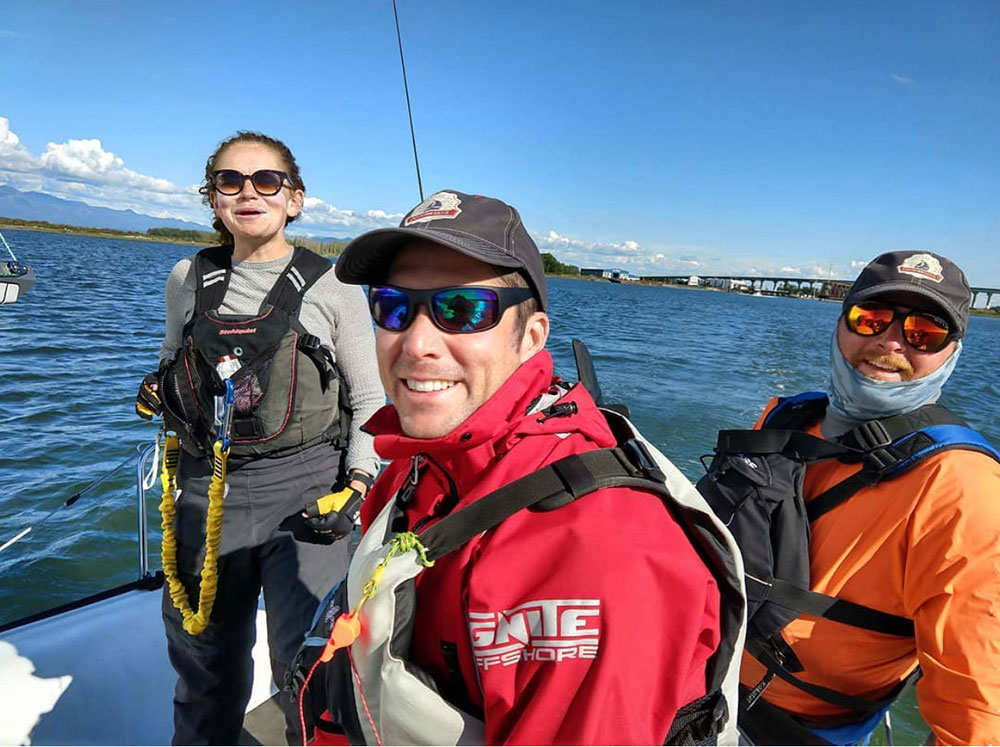
We burned the rest of the breeze on an awesome spinnaker run up to Shilshole under Ben and Judah’s. evening watch. We got to the marina at about midnight, where we stopped to fill up our water jugs and I ran down to my boat to kiss my sleeping dog and my husband who met us at the dock. In reality, we probably only stopped for about four and a half minutes, but it felt like we were on borrowed time. Back on the course, we made quick progress up towards Whidbey Island until the wind started to die around sunrise. We think we fell back a few places in the early morning to boats. who held their kites longer or could point a little better downwind. I, for one, was falling asleep at the helm.
Day 3 brought one of the biggest decisions of the race: Swinomish Channel vs. Deception Pass. You have to go through one or the other, and it’s not an easy choice. There wasn’t much wind, so we knew we’d be biking if we went up Swinomish, which is about 11 miles long. Deception would get us to the breeze faster but it also added an extra 5 miles, and the swell would be huge with the incoming tide. Team Mustang Survival Ocean Watch — the other Melges 24 in the race — was moving steadily in that direction, so we decided to try our luck with Swinomish. The current at LaConner turns a little later, so we still had a favorable river to carry us out at the time we got there. I steered us through some puffy conditions in the narrow, shallow channel where we navigated around various non-racing vessel traffic. We had been through once before on a practice sail, but on that run our pedal drive had failed halfway through. This time it held strong. In the end, we closed some of the distance between us and the top pack, but most boats did well on the outside too. We still think it was the right choice, but saw no major gains.
I asked the team about Bellingham Bay, which I happened to sleep through on this race as well as on our practice sail — I still have never seen that mark! Ben was also off watch, so all he could tell me was that the wind was under 10 knots because he was sleeping on the bottom of the bunk as opposed to on the walls. Judah remembers dousing and hoisting the kite and pedaling between wind lines, changing modes several times between Vendovi Island and Bellingham Bay. Inside the bay, the wind picked up, but Sarah said the mark was surprisingly hard to find, even in the daylight. After rounding, most boats went quite a ways south of Portage Island, careful of the reef that stretches almost all the way down to Bellingham rock. Not Sarah and Judah — they did some quick tidal math and found a narrow spot where, if you threaded the needle, you could make it through just south of the island itself. I’m not so sure we would have gone this way had the boat owner not been sleeping peacefully below deck, but they went for it.
When I awoke at midnight on Day 4, we were just exiting Hale Passage. We had plenty of breeze and it was building. Ben and I hoisted the spinnaker and sent it up to Point Roberts on a reach, going all out for what could be our last day on the course. I kept us reaching as high as I could, only turning down when I felt us start to slip. Ben trimmed the kite through every puff, all muscle. When we rounded the Point Roberts nun in the dead of night, all we could see was a blur of red as we sailed past.
Ben took the helm for a bit and pointed straight for the San Juan Islands. The wild thing was that we were moving so fast we kept scaring the fish, and because of the bioluminescence, you could see them darting away from the hull in every wave we crossed. As day broke, the breeze stayed on and one boat, Team Gulls on Buoys, dismasted in Rosario Strait. Sarah came on watch and took Ben’s place on the trapeze, and soon we found ourselves in a wind shift near Orcas — no longer able to hold our point. We woke Judah an hour before his shift ended, needing more weight on the rail and a fresh take on tactics. We adjusted our sails, and realized I had been driving for almost nine hours straight.
Around noon, I awoke from a very welcome nap and came on deck to find the Strait of Juan de Fuca dead calm as we approached Smith Island. Little did I know we would spend the next four-and-a-half hours pedaling, paddling, and quite literally pumping our mainsail through the home stretch, as the current started ebbing out of Puget Sound with a vengeance, impeding progress to the finish in Port Townsend. The wind was nowhere to be found. We furled the jib, sweated it out, and spent the last ounce of our mental energy picking a course through the strong adverse current sweeping us away from the point. I think I can speak for most teams that completed the course that afternoon when I say we laid it all out on the line, and I don’t think I’ve ever been so happy to see a finish line. I had no interest in pedaling another mile or eating another Mountain House for at least a month. Even if it was the lasagna.
There’s a great photo of us laughing as we ring the finish bell because, in true form, we all tried to ring it at the same time and no sound came out. Our significant others and our wonderful sponsor, Angela from Dockside Mail, had been total tracker junkies. They met us at the finish with champagne and a big sign for Team Gratitude.

We finished 8th, but what made us smile the most is that while we were on the water, we hit our goal of raising $2,000 for island conservation through the nonprofit Seacology. We congratulated Trickster and the Lost Boys, the teams who finished before and after us, and stayed awake just long enough to shower and order takeout.
The WA360 race was beautiful, exhausting, and really meaningful to me in so many ways. For many of us, this event represented PNW sailing finally reopening after such a long and difficult year. But it was also the biggest way I have challenged myself in a long time. Physically, mentally and as a sailor — this race stretched my abilities and forced me to go up a steep learning curve of an entirely new type of racing. I learned to drive the boat through some heavy air conditions, I learned more about sail trim and tactics than ever before, and I gained a lot of experience navigating at night. The water always keeps you humble and coming out of the training season that led up to this race, I am feeling really strong and confident in my ability to learn something new. We all had to prove ourselves in one way or another, and for me this was all about learning and having fun and that’s exactly what we did. The one thing I did not expect? I’m officially hooked on distance racing.
Genevieve Fisher is a lifelong sailor and active racer who lives aboard with her husband on a J/40 in Seattle, WA. She’s the Founder and Creative Director of Eco Collective. Check www.instagram.com/sailteamgratitude/ for a tour of the team’s race boat.
This article originally appeared in the July 2021 issue of 48° North. The title background image is by Heather J.

